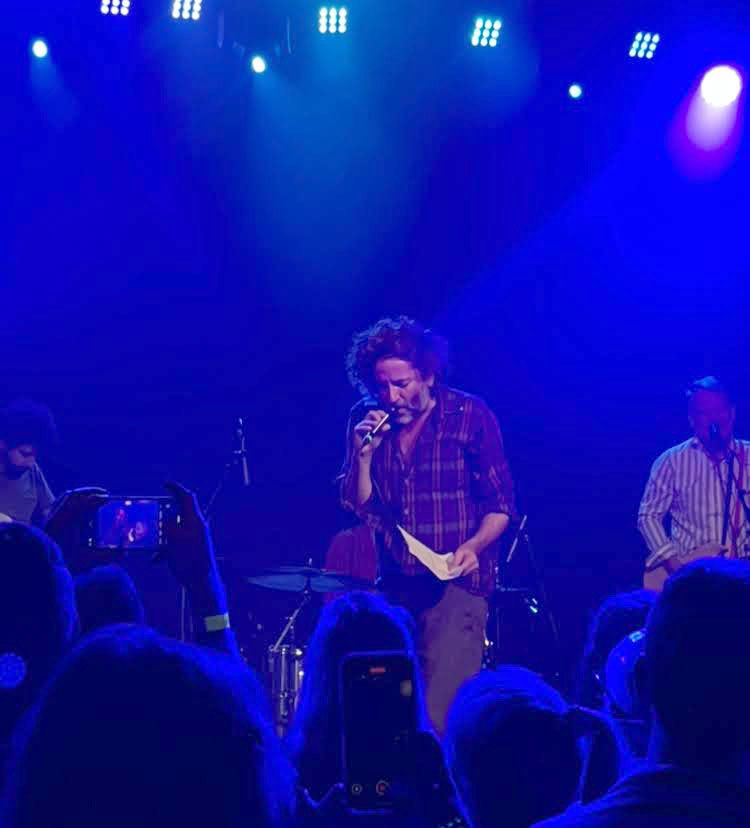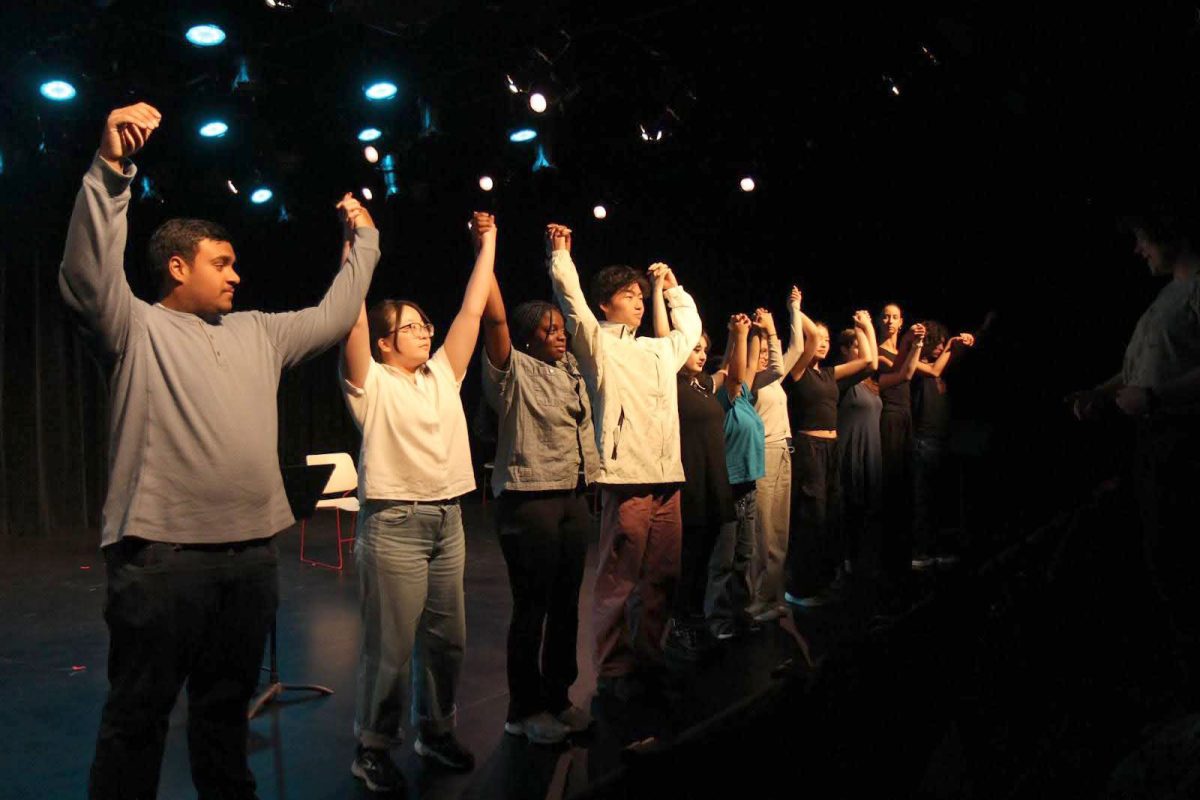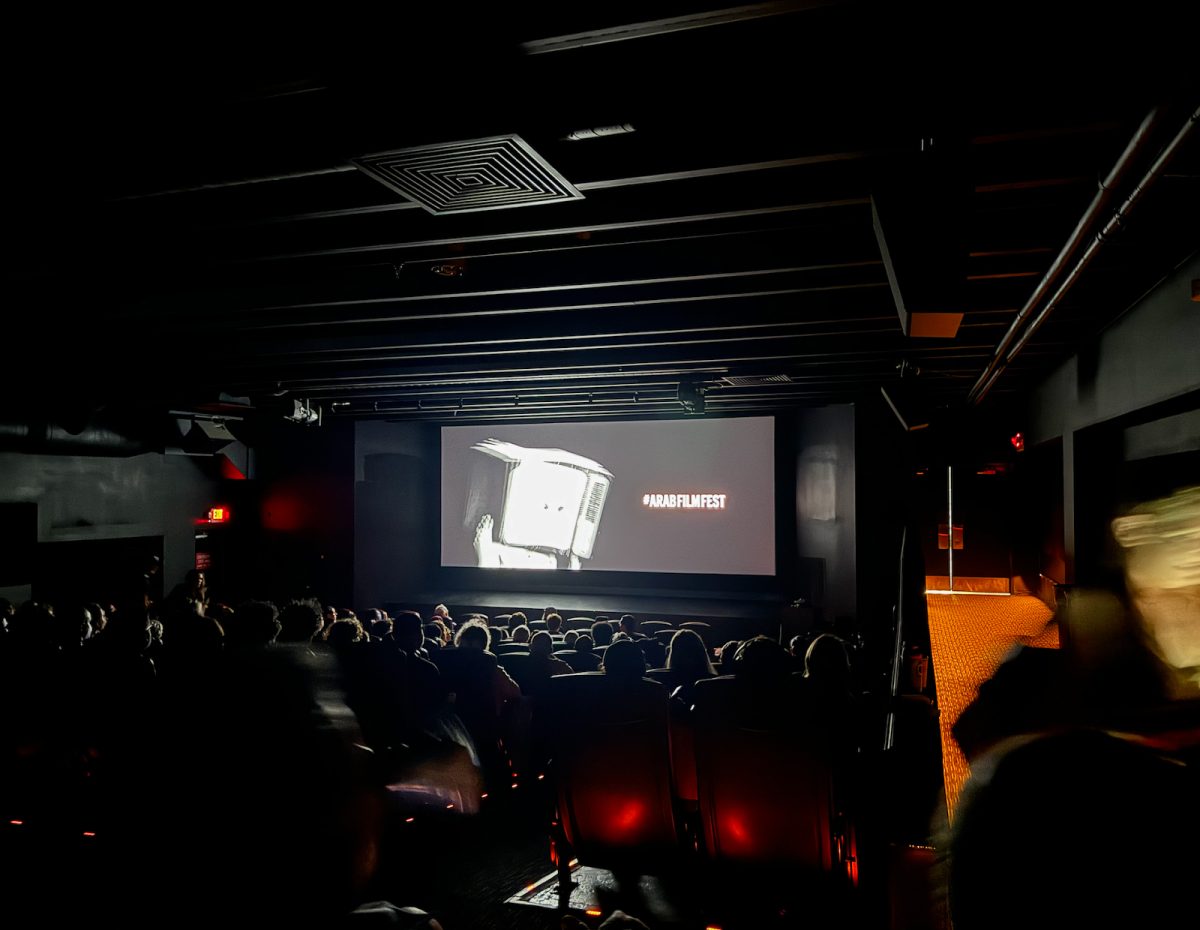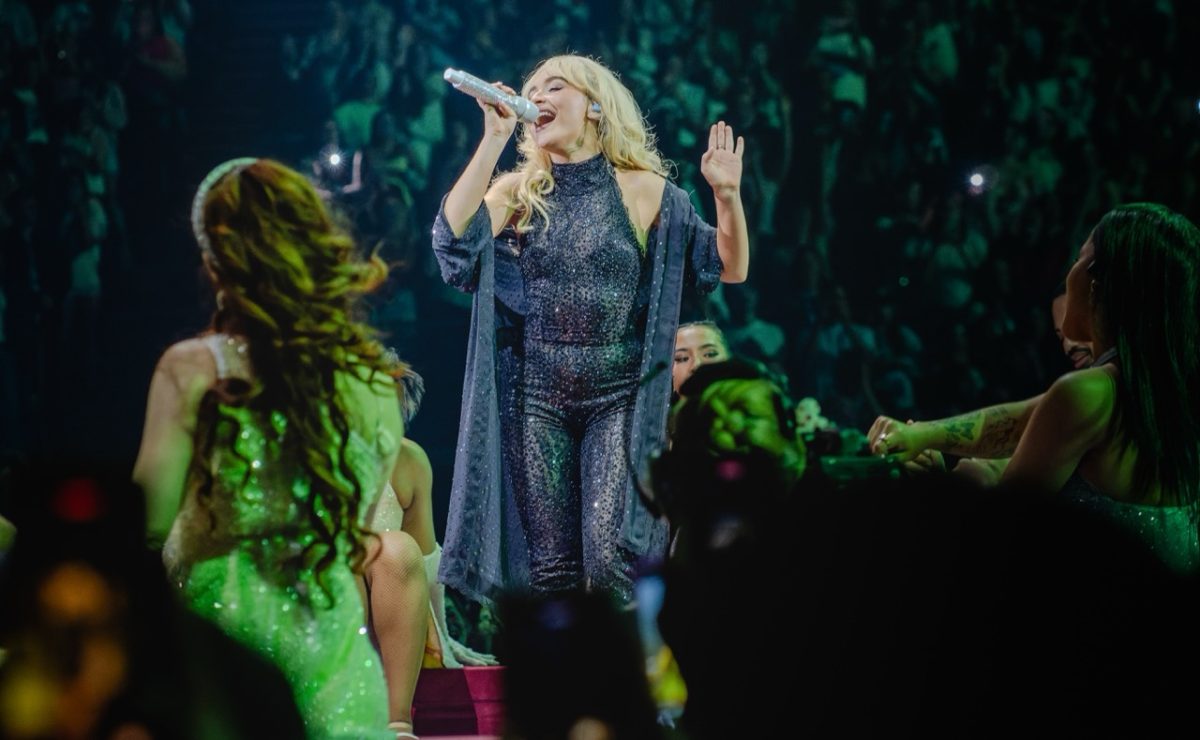
First tell me where you’re from?
I’m from St. Paul, Minnesota. I grew up about a mile and a half from Macalester’s campus.
And you wanted to stay close to home?
I didn’t. I did not apply to Mac out of high school, I went to Lewis and Clark College in Portland, OR. I decided during my freshman year that it wasn’t going to be where I would stay for the rest of my college career and I applied to transfer to Mac. I realized that it wasn’t the kind of school I wanted to go to, I just had to go halfway across the country to figure that out.
How did you pursue art before Mac?
The one thing that I’ve always been focused on is art, and I always believed that I would study it. I didn’t know if I would go to an art school and get a BFA in art or a liberal arts school, so I did a lot of art during my childhood and in high school, and towards the end of high school I started applying to visual arts schools and liberal arts schools. Up until April of senior year in high school I didn’t know if I would end up at an art school or not because I applied to a bunch of both and I was accepted to them so I had to tour and visit, and through that I realized that what I was looking for was not just visual art, it was a certain type of experience and community and that I would more likely find that at a liberal arts school.

So you went to L&C, and why didn’t that pan out?
I had a great experience there, I had a lot of fun. We were all into a lot of the same things, there was a lot of art going on there, I was in a band, I had a lot of really good friends—they’re still my best friends. But academically I didn’t feel that it was what I wanted, and I didn’t think I should go to a school just for the social or extracurricular environment. I came back here over break and started hanging out with some Macalester students, and I started thinking that Mac was more academically rigorous. I didn’t expect that that’s what I would want so much—there’s a lot of really passionate and engaged people here.
Has your art changed from when you started to the kind of work you do now?
I’ve changed the process, I used to do the kind of process that is more traditional in art: First I did drawing, then I got into painting, then I did sculpture, then I did printmaking, and then I got into more interactive installation work, and all of that has led up to what I do now which is mostly performance-inspired multi-media installation with a focus in photography and video [laughs]. So I wouldn’t say I’m a painter anymore, but I still use that language. Having arrived at the media that I work with now from all of those others, I think I can make photography or video as a painter or a drawer or a sculptor and approach it with all of these other languages. All of it is still present.

Can you talk about your performance art training?
It’s funny because it’s not really something I really connected to my visual art until [college]. I’ve always dabbled in dance… I’m a dance-dabbler! I did some gymnastics, and when I was ten I got involved with a circus and started doing artistic Cirque-du-Soleil type things, like aerials and contortion and body balance and trapeze. I’ve been doing that since I was ten, and I’ve moved from school to school to collective to studio but it’s been consistent. Right now I’m just doing aerial arts. Sophomore year [of college] was when I started to become more experimental with my art. Before that I’d done mostly painting and some sculpture, and once I transferred here I just felt like there were all these ideas I had for work I wanted to create that I didn’t have the opportunity to explore before.
Sophomore year I took an art history course called “Performance Praxis” with Joanna Inglot and Lara Nielsen and it completely changed the way I thought about art and produced art because it was about performance art. I realized through it that I am a performance artist because we looked at a lot of artists that blur that distinction [between visual and performance art]. I decided that I wanted to do the art that I wanted to do, so I did an independent study that spring with the sculpture professor where instead of using traditional materials I made a bunch of sculptures using hard candy recipes[….] The piece that I ended up making, and the whole experience was really transformative in my college career as an artist, at least, because I learned a lot about process and letting go and listening to what your art is trying to tell you, and not going into your piece with an idea of what you will create and with a set goal — instead going in with a question and then having fun. I learned that the hard way because that piece really resisted me. I think the final product was way better than anything I could have imagined going into it—I’m not that material, I’m not that art, I’m just somebody going in to help it along, and it had better ideas than me. That story is a bit of a rabbit hole, it’s got kind of a sad ending.

Can you tell it?
I was having a pretty hard time because I had transferred, because it’s [an] age where you’re transitioning from childhood to adulthood, and I was thinking about how I would always do these rituals in my life, sort of ridiculous things, as an effort to hold onto my childhood. I think it would have been more of an issue if I hadn’t transferred, just because I’m here in my hometown so close to my family, so I was faced with a lot of that. Here I am trying to turn into an adult in this space that I only know as a child. So I was trying to process that, and I thought I would make a piece that used a material that mimicked amber as a metaphor for something that preserves something from the past.
Amber’s expensive, so I ended up finding that hard candy was a really beautiful and cheap replacement for amber. The object that I ended up using [to preserve] was a ceramic cast of my mother’s breast. Somehow I convinced her to let me take a mold of her breast in the sculpture studio, and I used that because I felt that was symbolic of my childhood, what nurtured me, the farthest thing that I could go back to, and it’s also a really beautiful object—it looks like a shell. I had also never done ceramics and the professor showed me how—another thing that’s so great about Mac’s art department is that it’s so small and the professors are so dedicated that you can do anything you want to. So I had this mold [of a breast] and I would pour the hard candy in and then drop the breast in and then pour more hard candy in so it looks like it’s floating in the middle. It was so hard! Then I would take it out of the mold and I would have this beautiful red-orange, with the light coming through it, rock candy with this white ceramic breast suspended on the inside of it. I started doing it again and again, sort of my repeated efforts to hold onto this thing, so I made a bunch of them. But I would come back to the studio in the morning and the sculpture would have sort of flattened and spread across the table, like this slow-moving jello, and it was sticky. It got really down to chemistry and I didn’t know the specifics[…] Ultimately I had these different sculptures in varying stages of decay, all going into this candy puddle, and some were a deep gold and some were Coke bottle brown-red.
And I realized that that’s what my piece was—these repeated efforts to preserve this thing and make something that were ultimately futile, where I didn’t have control and I had to let them go. I had to work with my materials instead of against them, so I ended up scrapping a lot of my ideas. The piece was in preparation for the student show, and I finally decided to put them on a pedestal in the student gallery and let them melt all over the pedestal. They sat there for a week or two and just slowly spread and dripped. […] I didn’t deal with them over the summer and they stayed in the sculpture studio and continued to spread all over the floor and there were some rodent casualties—I’m a vegan and I killed like four animals with my artwork. One day I had to get them out of there and my mom offered to help me—again, I don’t know why, I would never help my child with a project like this—it was so hot, and we scraped and scrubbed for hours and got it all up. I wanted to hold onto them so badly, it was almost like the piece was a performance and I just didn’t want to let go of this thing that needed to be let go of. So we found a dumpster outside and dumpstered all these sculptures that I had spent my whole semester making, and I was so emotional about it because I was throwing away all of the evidence of my hard work and all of the hours I had spent making it, and I was just throwing all of that in the dumpster. It was like we had a little ceremony, we threw some dirt on the dumpster—and then the sky turned dark and the wind started blowing and this storm blew in! It was kind of dramatic. I thought it was interesting that my mom was there for the birth and the death of the piece. That piece was called Mammorial: efforts to preserve. Get it? That was the beginning of a more real exploration of concepts that I had been dancing around for a long time.
So how had your work evolved since then?
I kept playing around with different materials, and continued my investigation of the body and processes of transition and transformation and change and decay and growth, which are all consistent themes in my work. I produced some garments that I wore—again having some performative elements to them, but first and foremost they were objects. I made this one dress where I used a painter’s suit, which is almost like a transparent skin, and I filled hundreds of white balloons with sand and I sewed them onto it in this pattern that reads as udders or testicles or growths or organs spilling out…I either think of the piece as “Skinsuit” or “Outtards.” I was kind of exploring unnatural growth and excess and the aesthetic beauty of that. But then I sewed them all on and it got so heavy that it started ripping. So I bought a nylon beige négligée, which is really tough material that can hold them, but it’s a really heavy garment. It’s not a graceful thing, but I love that about it: that it’s cumbersome and awkward and it’s real; it’s got this gravity to it.
That was all a year ago. At that time I started to work with video which I had wanted to do for a long time because video, to me, is a way to explore performance and sculpture and installation because those are all things that you will capture in video. I started making some videos and playing around with the same themes that I had been exploring, as well as doing some more installation work, which was something I felt that I had been working towards for a long time. That all leads up to what I’m doing now, which is photography. It’s funny that I went through all of this art education before I studied photography because that’s something that these days I feel people learn a lot sooner than I did. But I think that because I waited so long, I am able to bring my sensibilities from drawing and painting and sculpture and performance and installation into photography, so a lot of the photography that I’ve been producing requires other people, social interaction, and there’s a performative quality to it. I’ll go into it with someone with an idea and then we play and collaborate, and from that I generate video and photography, which is a much more exciting way to work.
I’m not strictly working in photography or video either; I’m working with materials and installation, and I’m excited to produce pieces that are creating environments in which to experience my photos or video. Last semester I did a series in which I photographed people engaged in rituals with their bodies. Some of them were things like brushing your teeth or picking a scab or putting lotion on, but then there was also using the toilet or masturbating or someone changing a Diva Cup. They’re things that we all do, but some are more taboo than others. I wanted to explore why that distinction exists, and put all of those different rituals on the same playing field. It was a continuation of exploration into the body and processes that, as human beings, we must experience, even when they’re seen as grotesque or should be secret or they’re scary; things that suggest death. What I’m talking about right now could be defined by the word “abject”, which is this whole theory in psychoanalysis that’s a space that exists outside of subject and object and is what society tries to contain and fears, it’s this threat and this danger and this uncontrollable thing, and it’s represented in these very bodily processes; it suggests death. […] if you wanna read more about abjection, kids, read Julia Kristeva’s essay “The Powers of Horror”.

You’ve done some performance art related to horror, right?
Surprise! [Laughs] The Haunted Basement is this multi-media interactive performance installation art project that’s basically artists’ rendition of a haunted house that takes place yearly at the Soap Factory, which is an art space in Minneapolis. I’d always heard about it and thought it sounded terrifying and fucked up. About a year ago, it was the summer and I really wanted to get involved in a really big important art project and really devote myself to it, so I started volunteering at the Soap Factory and helping with the build and the installation of The Haunted Basement and I just got obsessed, I got sucked in. Everybody there was so fun and weird and creative, there was always so much going on and it was so massive. I thought I’d say goodbye to that once the school year started because the build was over, but then the run of the performances started in October and I got so into it. I started performing. I acted in The Haunted Basement, and that really occupied a lot of my fall. There’s a lot of taboo[…]that’s why I think it’s such a powerful experience, is because it gives people the opportunity to exist for a while in a space that allows for what normal everyday life does not. All the rules are different in the basement.
You mean for the people working there?
Both [the people working there and visitors]. To go through it you sign a waiver…not to relinquish your rights…but to say that you won’t sue them if you, for example, have a heart attack, or pee your pants, or trip on some ancient brick, or get upset. You have to be over 18, and people are given instructions; this year they went in with masks on and suits on because they got shot at by paintballs…well we didn’t shoot at them, we shot near them, just to splatter them. But there’s a lot of triggering things that happen in it, and throughout the run the upstairs folks that would be sending people down had to become more and more specific, like “there are PTSD triggers,” “there are claustrophobic situations,” “there is complete darkness,” because people would write them e-mails and get really upset that they had this experience. Some people are really uncomfortable being touched, some people are really uncomfortable in certain types of situations, and I think that’s really legitimate, but it’s also a fine line. You want to give people a good experience but there is a line of human decency and every individual coming through has their own baggage and their own history.

Can people get out of it?
Yes, there’s a safe word. If you say “uncle” we drop character and we walkie-talkie someone to come and get you. Otherwise we don’t drop character. I had a couple “uncles.” Because it’s this different space, it’s going to bring out different things in different people; things that you don’t have to face in normal life. I went kind of crazy…in an OK way, but when you hold this insane character for so long and you’re in this dark strobe-lit space with noise and people coming through and you’re by yourself and you’re not sleeping enough and you have all this adrenaline…it’ll do stuff to you! But it was also a blast. I had so much fun, way more fun than I expected. I was there almost every night by the end. I’m definitely going to be involved again, but I don’t know to what degree. Maybe the design, the build…I’m removed enough from it right now that I’m looking at it more critically and I’m wondering if it still is the place for me. I know that I felt so good being there and I had such an amazing time that I would be surprised if I didn’t have that experience again, who knows.
Can you give me a short preview into what we can look forward to in your senior show?
I almost don’t wanna say it. It’s mostly in my head, and in my journals and sketchbooks…I’m continuing to explore the body—surprise. I’m working with the ritual of bathing as a way to look at our relationship to the rest of the world and how bathing is this futile or temporary attempt to disconnect ourselves from all of the natural processes and imperfect elements of the world. Bathing is a way to declare ourselves as subjects separate from everything else, from the abject. That’s a very proper sounding way to put it, but really I just think that water and light and bodies are the most gorgeous things. I’m also exploring other materials besides water like food as a way to look at taboo and people deliberately engaging in “impure” practices. The whole back-and-forth between “pure” and “impure,” or “defiled” and “clean.” I’m also thinking about the relationship between ourselves and space, and how spaces can hold experiences. What I’m doing as I move towards the eventual piece, which will be a multi-media installation, is just going with the simple things I know, which are: people bathing. The environment produces the work. I’m just experimenting with the material, and it’s getting me farther and farther along.







Keith Davies • Sep 11, 2019 at 9:44 am
Can you please send by e-mail me the code for this script or please enlighten me in detail about this script?
Karen Parr • Sep 10, 2019 at 4:27 am
I acquired more a new challenge on this weight-loss issue. One issue is a good nutrition is especially vital when dieting. A huge reduction in bad foods, sugary food, fried foods, sugary foods, beef, and white colored flour products could possibly be necessary. Holding wastes parasites, and contaminants may prevent objectives for shedding fat. While specific drugs quickly solve the problem, the awful side effects are not worth it, and they also never offer more than a short-lived solution. It is just a known undeniable fact that 95 of dietary fads fail. Thanks for sharing your ideas on this web site.
Eric Bond • Sep 5, 2019 at 1:02 am
But a smiling visitant here to share the love (:, btw great pattern.
Damon • Aug 12, 2019 at 5:55 pm
Thanks I needed this